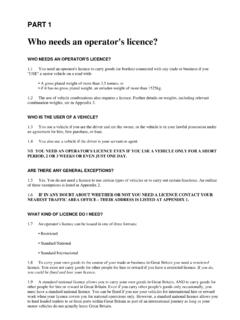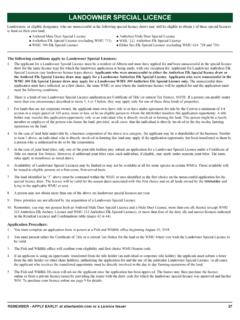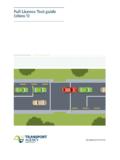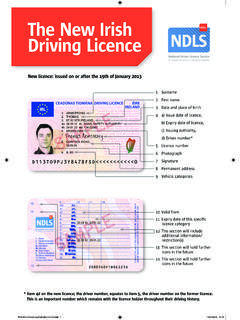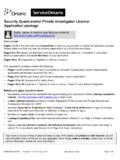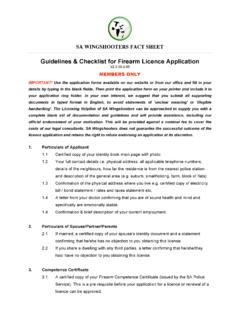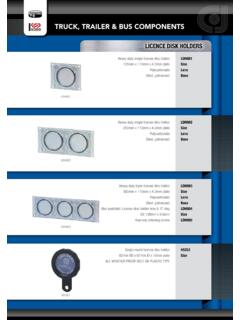Transcription of February 2009 Professional Operator’s Licence …
1 February 2009 For Tractor-Trailers, Buses, Large Trucks, Ambulances and TaxisProfessionalOperator s Licence InformationA supplement to the Basic Licence Driver's Professional Operator s Licence InformationTable of ContentsCHAPTER 1 Commercial Operator s Licence RequirementsUpgrading your Licence .. 4 Knowledge test ..5 Vision screening .. 5 Road test .. 6 Learning requirements .. 9 Licences: renewal and changes .. 9 Definitions ..10 CHAPTER 2 Operating Class 1 VehiclesSize and weight restrictions of commercial vehicles ..14 Reporting to an inspection station ..16 Vehicle inspections ..17 Pre-trip inspection for tractor-trailer and semi-trailer.
2 18 Air brake equipped vehicles ..29 Components of the supply circuit of a CMVSS 121 air brake system ..30 Primary brake circuit ..31 Secondary brake circuit ..32 The tractor-trailer air circuit ..34 The brake chambers ..35 Pre-trip air brake inspection ..37 Air brake equipped farm vehicles ..42 Rest and check stop inspections ..42 End of trip inspection and report ..44 Coupling and uncoupling a semi-trailer ..44 Coupling and uncoupling pintle hitch attachments ..45 Coupling mechanisms ..47 Link-up arrangement ..50 Operating long combination vehicles ..51 Load security ..53 Speed limits for long combination vehicles ..54 Braking distance.
3 54 Stopping distance ..56 General braking information ..57 Following distance between vehicles ..58 Off-tracking ..59 Turns ..59 Curves ..62 Parking ..64 Backing (reversing) ..65 National Safety Code ..70 Commercial Vehicle Inspection Program (CVIP) ..76 CHAPTER 3 Operating BusesInformation for Class 2 and Class 4 bus operators ..81 Vehicle inspections ..81 Pre-trip inspection ..82 Post-trip inspection ..88 Breakdowns ..89 Passenger loading and unloading ..90 Railway crossing procedures for school bus operators ..92 Reversing (backing) ..94 Turnarounds ..95 Parking on a hill ..97 Discipline and problem solving ..97 Safe driving guidelines.
4 98 Improve your qualifications and knowledge ..99 CHAPTER 4 Operating Class 3 VehiclesPre-trip inspection ..103 Parking on a hill ..110 Loading and unloading dump vehicle ..111 Mixer truck operators ..114 CHAPTER 5 Operating Class 4 VehiclesAmbulance vehicles ..117 Pre-trip inspection ..118 Defensive driving factors ..122 Operating a taxi ..124 Pre-trip inspection ..125 Fuelling a vehicle ..129 Seat belts ..129 Reserved lanes ..129 For hire ..130 CHAPTER 6 Transporting Dangerous GoodsWhat is a dangerous good? ..132 Dangerous occurrences ..138 Documents ..139 Safety marks ..139 CHAPTER 7 Transporting Persons with DisabilitiesGeneral rules for communicating.
5 143 General rules for driving ..144 General rules for assisting a person with a wheelchair ..144 CHAPTER 8 Railway Crossings, Fire and Fire Extinguishers, Fuelling a VehicleRailway crossings ..148 Know the law ..151 Fire and fire extinguishers ..153 Fuelling a vehicle ..156 Gasoline or diesel ..156 Propane ..157 IntroductionA message from Alberta TransportationBeing a Professional driver involves more than just driving a different type of vehicle. It means taking pride in your work and being recognized as a Professional a Professional driver you must always make sure you are mentally and physically fit to drive, your vehicle is well maintained and is in good working condition, and you drive within the drive defensively.
6 Be patient and tolerant of other drivers. Protect yourself, the vehicle, the passengers and the cargo. The more you can anticipate and avoid dangerous situations, the less likely you will be in a collision. Being involved in a collision may result in loss of income, job, health and possibly a that road safety is everyone s TransportationThis handbook is also available site: (under Drivers and Vehicles)DATE: February 20091 This handbook, along with the Basic Licence Driver s Handbook, will give you the necessary information for learning to drive a truck, tractor-trailer, ambulance, taxi or bus. These two handbooks provide information that will help you obtain a Professional Alberta operator s Licence .
7 We recommend that you enroll in driver training to supplement your knowledge and skill. You may want to keep a copy of these handbooks in the vehicle as a further information is required regarding driver training schools or the driver examination process, please contact a Driver Programs Administrator at:Edmonton 780-427-8901 or Calgary 403-297-6679 For toll-free service from anywhere in Alberta, call handbook is a guide only and has no legal authority. The laws that apply to driving a vehicle can be found in the Traffic Safety Act and its related regulations. This information is available from:Queen s Printer Bookstore Park Plaza Building 10611 98 Avenue Edmonton, Alberta T5K 2P7 780-427-4952 For toll-free service from anywhere in Alberta, call 310-0000.
8 These laws are also available site: Municipalities are given authority under the Traffic Safety Act to pass bylaws in areas such as speed zones, school zones, playground zones and parking. You must know local municipal this handbook carefully. Enjoy being a safe 1 Commercial Operator s Licence Requirements14 Commercial Operator s Licence RequirementsInformation about the different Alberta operator s Licence classes, and the vehicles that can be operated in each class, can be found in the Basic Licence Driver s Handbook. All handbooks are available from any Registry Agent office or on-line at Alberta Transportation s web site at: To locate a Registry Agent in your area, please refer to the local telephone SuperPages under Licence and Registry Services.
9 You can also check on-line at: Upgrading your licenceThe following information is specific for upgrading an operator s Licence to the Professional classes. General information for Classes 1, 2, 3 and 4 The minimum learning or licensing age for these classes is 18 years. To learn to drive a Professional class vehicle, you must have at least a Class 5 or a Class 5 Graduated Driver Licensing Program (GDL) operator s Licence . You may not apply for any Professional class of operator s Licence if you are a probationary driver under the Graduated Driver Licensing Program. You do not need an air brake endorsement when learning to operate a vehicle that is equipped with air brakes.
10 A medical report is required to upgrade to a Class 1, 2 or 4 Licence . * Medical forms are available from a Registry Agent or a doctor. A doctor must complete this * A medical report is required when first applying for a Licence and: every 5 years after that, until 45 years of age every 2 years from age 45 to 65 every year after you turn age 65. * You are legally responsible to report any disease or disability that may interfere with the safe operation of a motor vehicle to any Alberta Registry Agent office. * Alberta Registries can request a medical report from any driver, in any Licence class, if they have concerns about a driver s medical condition.






